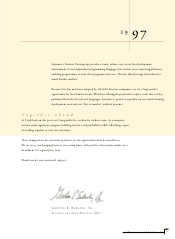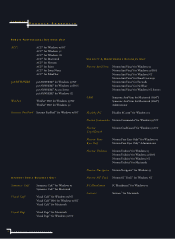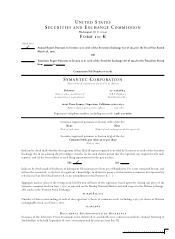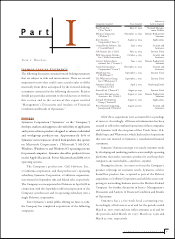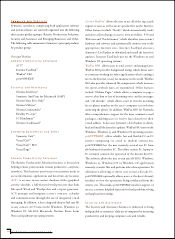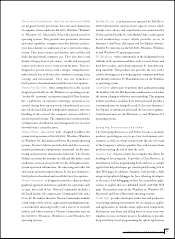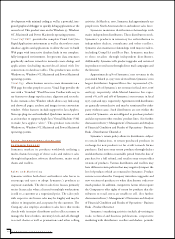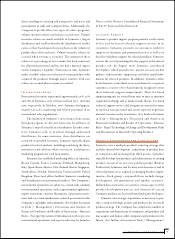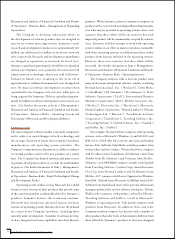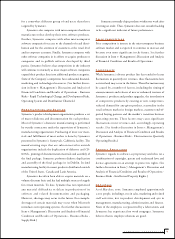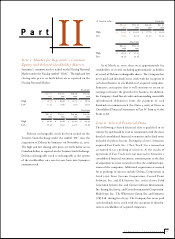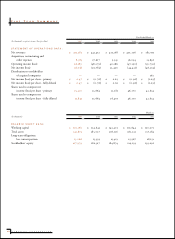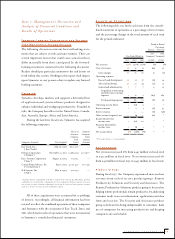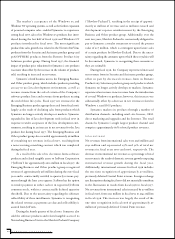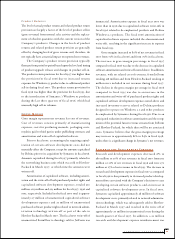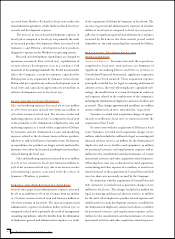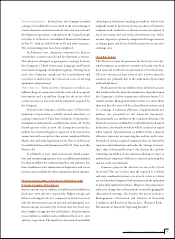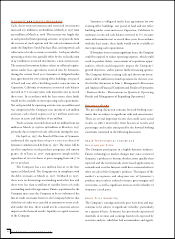Symantec 1997 Annual Report Download - page 17
Download and view the complete annual report
Please find page 17 of the 1997 Symantec annual report below. You can navigate through the pages in the report by either clicking on the pages listed below, or by using the keyword search tool below to find specific information within the annual report.
for a somewhat different group of end users than those
targeted by Symantec.
Symantec also competes with microcomputer hardware
manufacturers that develop their own software products.
Further, Symantec competes with other microcomputer
software companies for access to the channels of retail distri-
bution and for the attention of customers at the retail level
and in corporate accounts. Finally, Symantec competes with
other software companies in its efforts to acquire products or
companies and to publish software developed by third
parties. Symantec believes that competition in the industry
will continue to intensify as most major software companies
expand their product lines into additional product categories.
Some of the Company’s competitors have substantial financial,
marketing and technological resources. (See further discus-
sion in Item 7: Management’s Discussion and Analysis of
Financial Condition and Results of Operations - Business
Risks - Rapid Technological Change and Development Risks,
Operating System and Distribution Channels.)
Manufacturing and Backlog
Symantec’s product development organization produces a set
of master diskettes and documentation for each product.
Most of Symantec’s domestic manufacturing is performed
by outside contractors under the supervision of Symantec’s
manufacturing organization. Purchasing of most raw mate-
rials and fulfillment of most orders is done by Symantec
personnel in Symantec’s Sunnyvale, California facility. The
manufacturing steps that are subcontracted to outside
organizations include the duplication of diskettes and CD-
ROM’s, printing of documentation materials and assembly of
the final package. Symantec performs diskette duplication
and assembly of the final package in its Dublin, Ireland
manufacturing facility for most products distributed outside
of the United States, Canada and Latin America.
Symantec has often been able to acquire materials on a
volume-discount basis and has had multiple sources of supply
for certain materials. To date, Symantec has not experienced
any material difficulties or delays in production of its
software and related documentation and packaging.
However, shortages may occur in the future. For example,
shortages of certain materials may occur when Microsoft
introduces new operating systems. (See further discussion in
Item 7: Management’s Discussion and Analysis of Financial
Condition and Results of Operations - Business Risks -
Supply Risk.)
Symantec normally ships products within one week after
receiving an order. Thus, Symantec does not consider backlog
to be a significant indicator of future performance.
Price Competition
Price competition is intense in the microcomputer business
software market and is expected to continue to increase and
become even more significant in the future. See further
discussion in Item 7: Management’s Discussion and Analysis
of Financial Condition and Results of Operations.
Seasonality
While Symantec’s diverse product line has tended to lessen
fluctuations in quarterly net revenues, these fluctuations have
occurred and may occur in the future. These fluctuations may
be caused by a number of factors, including the timing of
announcements and releases of new or enhanced versions of
Symantec’s products and product upgrades, the introduction
of competitive products by existing or new competitors,
reduced demand for any given product, seasonality in the
retail software market in foreign markets, customer end-of-
period buying patterns and the market’s transition between
operating systems. These factors may cause significant
fluctuations in net revenues and, accordingly, operating
results. (See further discussion in Item 7: Management’s
Discussion and Analysis of Financial Condition and Results
of Operations - Business Risks - Fluctuations in Quarterly
Operating Results.)
Product Protection
Symantec regards its software as proprietary and relies on a
combination of copyright, patent and trademark laws and
license agreements in an attempt to protect its rights. (See
further discussion in Item 7: Management’s Discussion and
Analysis of Financial Condition and Results of Operations -
Business Risks - Intellectual Property Rights.)
Employees
As of March 31, 1997, Symantec employed approximately
2,000 people, including 1,000 in sales, marketing and related
staff activities, 600 in product development and 400 in
management, manufacturing, administration and finance.
None of the employees is represented by a labor union, and
Symantec has experienced no work stoppages. Symantec
believes that its employee relations are good.
15
SYMANTEC CORPORATION


